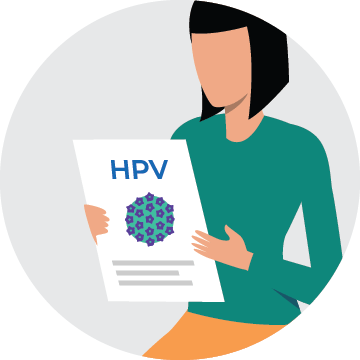HPV screening and follow-up pathway
Education and awareness for eligibility and invitation
 Recommendation: Support primary care providers to address patient concerns and questions regarding HPV primary screening safety, efficacy and changes in eligibility and frequency.
Recommendation: Support primary care providers to address patient concerns and questions regarding HPV primary screening safety, efficacy and changes in eligibility and frequency.
Key evidence and implementation considerations:
- Participants may have concerns around the change in cervical screening frequency and age of initiation, and may fear a missed cancer diagnosis.1,2
- Develop and deliver public and participant education on the safety and effectiveness of HPV primary screening, and on what these changes mean for participants.
- Jurisdictions should adapt current education and recruitment communications for screening invitation and recall (e.g., participant correspondence) to reflect changes from Pap tests to HPV primary cervical screening.
- Clinicians can help address disparities in HPV-related knowledge and perceptions of cervical cancer screening, and can increase patient confidence and trust in HPV primary screening by demonstrating the ease of use and accuracy of self-sampling methods.
- Develop educational materials that primary care providers can use to clearly explain the benefits of HPV primary screening and educate on the harms of over-screening.
Concepts to cover in educational materials on HPV primary screening
- Information on the natural history of HPV infection and cervical cancer, including research evidence that demonstrates how HPV testing allows for earlier and better detection of cervical pre-cancer and cancer compared to cytology testing.1,3
- Research evidence that supports delayed initiation of screening and longer intervals between screens. For example, the negative predictive value (NPV) of HPV testing is 99%, meaning nearly all negative tests can be considered true negatives.3 As a result, screening intervals can be safely lengthened, and participants can be screened less frequently.
- The potential harms of over-screening. For example, follow-up colposcopy and loop electrosurgical excision procedure (LEEP) treatments are invasive and may increase the risk of adverse pregnancy outcomes.
- Jurisdictions should support primary care providers to discuss the benefits of HPV prophylactic vaccination and promote vaccination among their patients over 26 years of age who have not been vaccinated previously or who have not completed the series.
- Consulting evidence from international jurisdictions may be helpful to understand participant concerns as well as the strategies that can be employed to support screening uptake.2 The HPV Primary Screening and Abnormal Screen Follow-Up Environmental Scan highlights how other countries have implemented HPV primary screening in their organized cancer screening programs.
- The transition from Pap-based to HPV-based cervical screening may be an emotional process for some screening participants. Jurisdictions should support primary care providers to address any anxieties or fears that participants bring forward.
Recommendation: Consider a variety of strategies for public and participant education and awareness of HPV primary screening and make materials available to the public through multiple channels.
Key evidence and implementation considerations:
- To help ease participants into the shift to HPV-based screening, education materials and public-awareness campaigns should be developed and distributed before programs begin HPV primary screening.
- Public-awareness campaigns should be developed collaboratively with the intended audience and the information should be presented by trusted sources.
- Meaningful and respectful engagements should take place to understand the local context for development and delivery of public awareness campaigns.
- Educational materials should be culturally appropriate and reflect the local context. End users should be consulted to ensure educational materials meet their needs and enable equity in cervical screening participation.
- To reduce the stigma associated with HPV as a sexually transmitted disease, education should strive to normalize HPV, emphasize its high prevalence, focus on HPV testing for the purposes of cancer prevention, and reassure participants by explaining how their privacy will be protected during the screening process.4
- Communications should be user-friendly and written in plain language, and could include answers to commonly asked questions most relevant to the public and screening participants.
- Programs should ensure easy access to screening program websites for additional information.
 Key takeaway: Considerations for transgender and gender-diverse populations
Key takeaway: Considerations for transgender and gender-diverse populations
Specific attention should be given to the language used in all communications about HPV screening to ensure it is inclusive and welcoming to all people, regardless of gender.4
For example, processes and language should be available to care providers to help them appropriately support transgender and gender-diverse patients they treat to participate in cervical screening, including identifying the sex of their patients and educating them on why cervical screening participation is important.
- Smith LW, Racey CS, Gondara L, et al. Women’s acceptability of and experience with primary human papillomavirus testing for cervix screening: HPV FOCAL trial cross-sectional online survey results. BMJ Open. 2021; 11:e052084. doi:10.1136/bmjopen-2021-052084
- Obermair HM, Dodd RH, Bonner C, et al. ‘It has saved thousands of lives, so why change it?’ Content analysis of objections to cervical screening programme changes in Australia. BMJ Open. 2018; 8(2), e019171.
- Canadian Partnership Against Cancer. National guidance document on HPV testing for primary screening of cervical cancer. 2016.
- Access Alliance. Critical discussion report: Reducing inequities in cervical cancer screening among newcomer women via HPV self-sampling. 2022.
